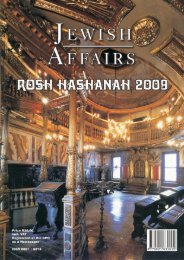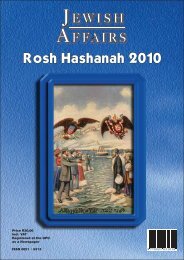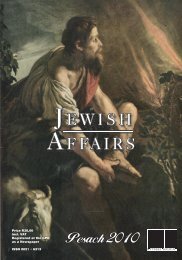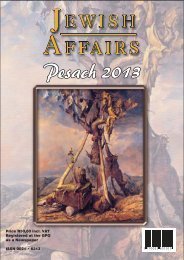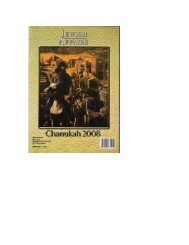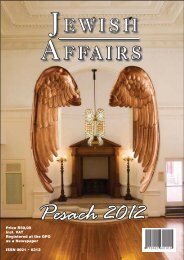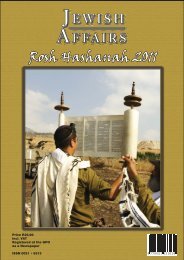Jewish Affairs - South African Jewish Board of Deputies
Jewish Affairs - South African Jewish Board of Deputies
Jewish Affairs - South African Jewish Board of Deputies
- No tags were found...
You also want an ePaper? Increase the reach of your titles
YUMPU automatically turns print PDFs into web optimized ePapers that Google loves.
JEWISH AFFAIRS ROSH HASHANAH 2012Lüderitz was a very German town, as could beseen in the local architecture, the most beautifulGerman China glass on sale in the shops, theclothing people wore and so many other touches.There were only about 1500 white people and3000 blacks. Our good friends were Wilfred andMolly Lubowski, whose son, Anton, was laterassassinated by the government because <strong>of</strong> hispolitical activities.Luckily, I spoke German. I started the ArtsAssociation, dabbled in clay and plaster <strong>of</strong> Parisand gave lessons in English, Scandinavianembroidering and drawing. I loved the colours <strong>of</strong>the sand dunes, the sunsets and the semi-preciousstones along the beach, called Agate Beach. Today,Namibia is a great tourist destination. I understandthat it has a harsh climate, but there is so much tosee. There are no words to describe the desert, therocks, the mountains and the sheer openness <strong>of</strong>the country.I cannot say that I was sorry to leaveLüderitzbucht. Being so high spirited and excitedabout life in general, I had been stagnating at astill young age. A short spell followed in Umtata,Eastern Cape, where Larry went for a refreshercourse. It was heaven, moving from a very Germanto a very English environment. Certainly, it is one<strong>of</strong> the most beautiful parts <strong>of</strong> <strong>South</strong> Africa. It wasthere that my inspiration began to return. I joinedthe opera group and started sculpting and painting,sculpture being my main interest. Umtata was asmall town, but very much alive. There was awide array <strong>of</strong> different ethnic groups, whose artand craftwork were so colourful.On my return to Windhoek, I fixed up a studioand started sculpting in earnest. As I have saidpeople, all people, interested me. One can take aphoto, but working in clay or plaster in threedimensions is really to get to the inside <strong>of</strong> theperson. It also enables the artist to spend timewith those they are portraying, conversing withand learning all about them. One becomes a kind<strong>of</strong> psychologist after a while. You would bestaggered to learn some <strong>of</strong> the things that sittershave confided to me!Larry was a modest, humble human being,quite opposite to me in many ways. He wascompletely devoted to his patients, expending adegree <strong>of</strong> time and effort on their behalf thatcontrasts strongly with the way the medicalpr<strong>of</strong>ession operates today. Often, he would sendme patients who were depressed, bringing theminto my art classes where we helped them toregain some confidence in themselves. I also usedto help people who had been ill or injured get backthe use <strong>of</strong> their hands by using clay. After ourmove to Johannesburg in 1973, Larry was incharge <strong>of</strong> looking after political detainees. It wasa trying, <strong>of</strong>ten heart breaking time, but thankgoodness they were so well treated by him. Hewrote his own memoirs before his passing someseven years ago.When we moved to Johannesburg, I neverdreamt that I would be accepted into the GoldenCity art scene, but with the friendship <strong>of</strong> CecilSkotnes, Larry Scully and one or two others, mycareer soon took <strong>of</strong>f. I knew that it was not goingto be easy, but I really wanted to be a portraitsculptor. I was given an exhibition by NormaWolfewitz, who had opened a gallery, andexhibited with an English painter. To myastonishment, I sold all fourteen <strong>of</strong> my Namibianethnic heads. I now began getting regularcommissions and never needed another exhibition.I had some wonderful exciting times, travellingto many parts in <strong>South</strong> Africa to do my subjects.After doing a portrait, I would always put down inwriting my feelings about the work just done andthe characters <strong>of</strong> the people depicted.The materials with which sculptors work vary.I was introduced to clay plaster <strong>of</strong> cement fondue,a metallic cement (it has a high aluminium content)from France, by Frank McWilliam in England.One <strong>of</strong> the top sculptors <strong>of</strong> the day, he wascommissioned to do the head <strong>of</strong> the Herero ChiefHosea, to be placed in the United Nations buildingin New York. I was introduced to him by myfather, and he became my mentor and great friend.He taught me so much and I met many interestingpeople through him. When I got home, I could notstop working. One <strong>of</strong> my main subjects was theBushmen people, without whose art we wouldhave no history <strong>of</strong> our forebears <strong>of</strong> tens <strong>of</strong>thousands <strong>of</strong> years ago. I learnt so much and hadsome glorious experiences with them.Anthropology is magical to me. I could easilyhave become an anthropologist, and also apalaeontologist. I read whatever I could lay myhands on regarding this, and as it turned out cameto do the heads <strong>of</strong> Philip Tobias and RaymondDart, two great world authorities in the field.These heads are now at the Medical School atWits University. Philip and I remained dear friendsuntil his passing earlier this year.Portraiture is the orphan <strong>of</strong> the art world butmake no mistake, it is exciting and exhilarating.I did my work because I loved the interaction withthe subjects, not for financial gain. I honoured thepeople I felt were <strong>of</strong> historical importance, andmoney could not buy that.I began receiving commissions from far andwide. When I was approached by MangosuthuButhelezi <strong>of</strong> the Zulu nation to do King Shaka, Iwas overjoyed. King Goodwill Zwelethini,members <strong>of</strong> the family and Buthelezi himselfwere constant visitors. The unveiling took placein 1979, the centenary <strong>of</strong> the Anglo Zulu War.There were many guests from the UK, and myheart was full being part <strong>of</strong> that historical event.I was then commissioned to do Lieutenant-Colonel Arthur Johnstone, Chief Scout <strong>of</strong> <strong>South</strong>Africa. This commission lead to a friendship Iwas extremely proud <strong>of</strong>. He was the Prior <strong>of</strong> StJohns, Lt-Col <strong>of</strong> the Transvaal Scottish Regimentand head <strong>of</strong> various mining companies. His wife,Irene, became one <strong>of</strong> my very dearest friends. The5



